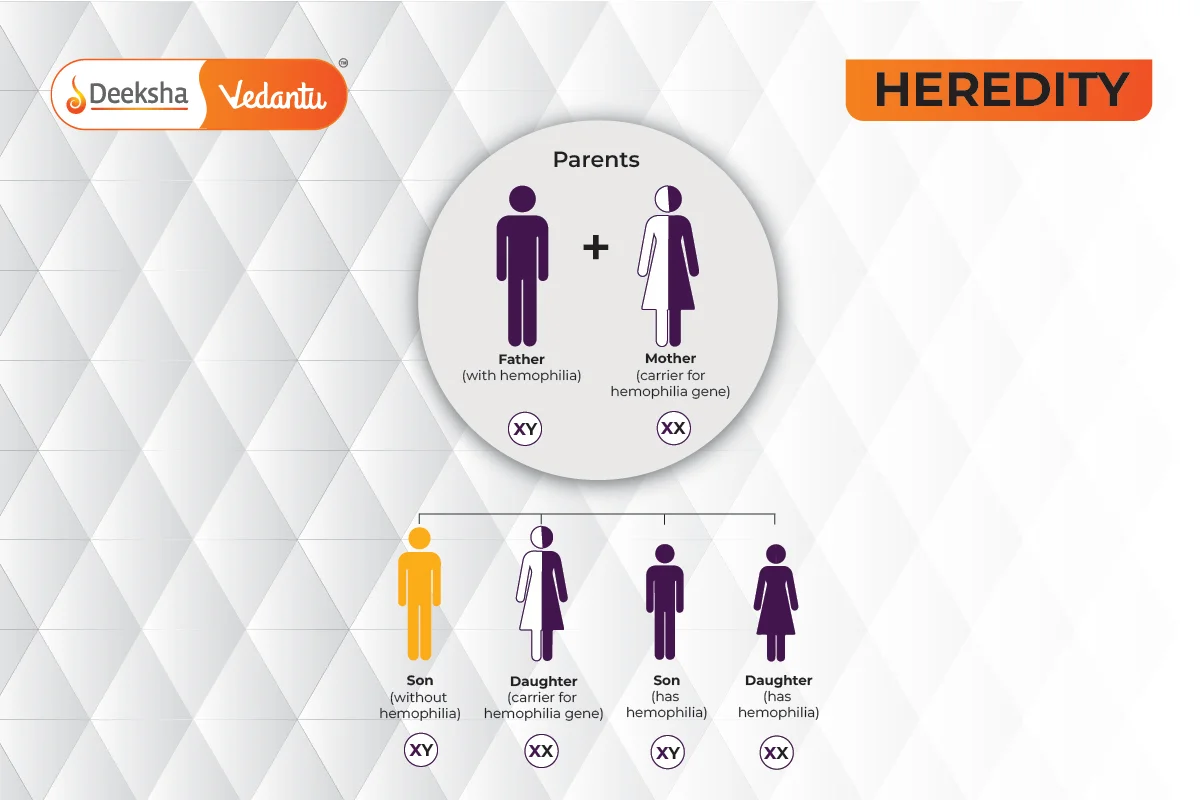Introduction
Heredity is the transmission of genetic characteristics from parents to offspring. This chapter covers how traits are inherited, how variations arise during reproduction, and the rules of inheritance. Understanding heredity is fundamental for grasping concepts like genetic diversity, evolution, and biological inheritance.
Accumulation of Variation During Reproduction
During reproduction, the offspring produced are not exact copies of their parents. Small differences, or variations, arise in the genetic material of the offspring, making them slightly different from their parents. These variations are important for the survival of species, especially in changing environments.
How Variations Arise:
- Asexual Reproduction: In asexual reproduction, variations are fewer because the offspring inherit genetic material from a single parent. Any variations are due to small errors in DNA replication.
- Example: A bacterium undergoing binary fission may have a slight variation in its DNA due to an error in copying its genetic material.
- Sexual Reproduction: In sexual reproduction, variations arise due to the mixing of genetic material from two parents. This results in offspring that are genetically different from both parents.
- Example: Humans inherit half their genes from their mother and half from their father, resulting in unique combinations of traits such as height, skin color, and eye color.
Importance of Variation:
Variations are essential for the survival of species. While some variations may be neutral or even harmful, others can provide a survival advantage under certain environmental conditions.
- Example: Some bacteria may develop a variation that makes them resistant to antibiotics, allowing them to survive and reproduce even in the presence of these drugs. This leads to the evolution of antibiotic-resistant strains.
What is Heredity?
Heredity is the process by which genetic traits are passed from parents to offspring. It is governed by genes, which are units of inheritance located on chromosomes. Each individual inherits a set of chromosomes (and hence genes) from each parent, which determines their traits.

Inherited Traits:
Inherited traits are characteristics passed from parents to offspring through their genes. These traits include physical characteristics like eye color, height, and blood type, as well as certain behaviors.
- Example: A child may inherit curly hair from one parent and straight hair from the other. The dominant trait (curly hair) may be expressed in the child.
Role of Genes:
Genes are segments of DNA that carry the instructions for building proteins, which in turn determine traits. For each trait, an organism inherits two alleles (one from each parent). These alleles can be dominant or recessive, and the combination determines the expression of the trait.
Mendel’s Contribution to Heredity
Gregor Mendel, an Austrian monk, is known as the father of genetics. His experiments on pea plants laid the foundation for understanding how traits are inherited. Mendel’s work established the basic principles of heredity, including dominance, segregation, and independent assortment.
Mendel’s Experiments on Pea Plants:
Mendel chose pea plants for his experiments because they had easily observable traits (such as flower color and seed shape) and could be cross-pollinated easily. He focused on monohybrid crosses (involving one trait) and dihybrid crosses (involving two traits).
- Monohybrid Cross: Mendel crossed a tall pea plant (TT) with a short pea plant (tt). In the F1 generation, all plants were tall (Tt). In the F2 generation, the offspring showed a 3:1 ratio of tall to short plants.
- Dihybrid Cross: Mendel crossed plants that differed in two traits, such as seed shape (round or wrinkled) and seed color (yellow or green). In the F2 generation, the traits were inherited independently of each other, leading to a 9:3:3:1 ratio.
Mendel’s Laws of Inheritance:
- Law of Dominance: In a pair of contrasting traits, one trait is dominant and expressed, while the other is recessive and hidden.
- Example: In pea plants, the allele for tallness (T) is dominant over the allele for shortness (t), so a plant with the genotype Tt will be tall.
- Law of Segregation: During the formation of gametes, the two alleles for a trait segregate (separate) so that each gamete carries only one allele for each trait.
- Example: A plant with the genotype Tt will produce two types of gametes: one carrying the T allele and one carrying the t allele.
- Law of Independent Assortment: Genes for different traits are inherited independently of each other. This applies to genes located on different chromosomes.
- Example: The inheritance of seed color in pea plants does not affect the inheritance of seed shape.
How Do Traits Get Expressed?
The expression of traits is controlled by alleles. Alleles can be dominant or recessive, and the combination of alleles an individual inherits determines which traits are expressed.
Dominant and Recessive Traits:
- Dominant Trait: A dominant allele masks the effect of a recessive allele. A dominant trait is expressed when an individual has either one or two copies of the dominant allele (TT or Tt).
- Recessive Trait: A recessive trait is only expressed when an individual inherits two copies of the recessive allele (tt).
Example:
- In pea plants, the allele for tallness (T) is dominant over the allele for shortness (t). Therefore, a plant with the genotype TT or Tt will be tall, while a plant with the genotype tt will be short.
Genotype vs. Phenotype:
- Genotype refers to the genetic makeup of an organism (the combination of alleles it has).
- Phenotype refers to the physical expression of a trait (what the organism looks like).
Example:
- A pea plant with the genotype TT or Tt will have the phenotype of being tall, while a plant with the genotype tt will have the phenotype of being short.
Sex Determination
In humans and many other organisms, the sex of an individual is determined by specific sex chromosomes. Humans have 23 pairs of chromosomes, with one pair being the sex chromosomes (XX for females and XY for males).
How Sex is Determined:
- Females have two X chromosomes (XX), and males have one X and one Y chromosome (XY).
- During reproduction, the mother always contributes an X chromosome, while the father can contribute either an X or a Y chromosome. If the father contributes an X chromosome, the offspring will be female (XX). If the father contributes a Y chromosome, the offspring will be male (XY).
Other Methods of Sex Determination:
In some species, sex determination is influenced by environmental factors rather than chromosomes.
- Example: In some reptiles, the temperature at which eggs are incubated determines the sex of the offspring. Higher incubation temperatures may result in more females, while lower temperatures may produce more males.
Inheritance of Traits and Chromosomes
Traits are controlled by genes, which are located on chromosomes. Each individual inherits two sets of chromosomes, one from each parent, which explains the inheritance of traits. Mendel’s laws help explain how these traits are passed down through generations.
Chromosomal Basis of Inheritance:
Genes are located on chromosomes, and during sexual reproduction, the chromosomes from each parent combine to give the offspring a set of genes. The segregation and independent assortment of chromosomes during the formation of gametes explain Mendel’s observations of inheritance.
Linkage and Crossing Over:
- Linkage: Sometimes, genes that are located close together on the same chromosome tend to be inherited together. This is known as linkage.
- Crossing Over: During meiosis, homologous chromosomes may exchange segments of DNA in a process called crossing over, which increases genetic diversity.
Real-Life Applications of Heredity
- Genetic Counseling: Genetic counseling helps families understand the risk of inherited genetic disorders, such as Down syndrome or Huntington’s disease. By analyzing family history and genetic testing, doctors can assess the likelihood of passing these conditions to future generations.
- Selective Breeding: Farmers use selective breeding to improve plant and animal characteristics. By choosing individuals with desirable traits, they can produce offspring with better yields, disease resistance, or faster growth.
- Forensic Science: DNA profiling is used to solve crimes by comparing the DNA found at crime scenes with the DNA of suspects. Since each person’s DNA is unique (except for identical twins), this technique is highly accurate.
Practice Questions
Q1: Explain the importance of variation in sexual reproduction.
- Answer: Variation is important because it allows populations to adapt to changing environments. Genetic diversity increases the chances that some individuals in a population will have traits that help them survive and reproduce under new conditions.
Q2: What is Mendel’s Law of Segregation? Provide an example.
- Answer: Mendel’s Law of Segregation states that during the formation of gametes, the two alleles for a trait separate, so each gamete carries only one allele. For example, a pea plant with the genotype Tt will produce gametes with either the T allele or the t allele.
Q3: How does sex determination occur in humans?
- Answer: In humans, sex determination is based on the inheritance of sex chromosomes. The mother provides an X chromosome, while the father provides either an X chromosome (resulting in a female) or a Y chromosome (resulting in a male).
FAQs
Mendel discovered the basic principles of heredity, including the Law of Dominance, the Law of Segregation, and the Law of Independent Assortment, by experimenting with pea plants.
The sex of a child is determined by the sex chromosomes. The mother always provides an X chromosome, while the father provides either an X (resulting in a female) or a Y (resulting in a male).
Dominant traits are expressed when at least one dominant allele is present, while recessive traits are only expressed when both alleles are recessive.
Heredity is the process by which traits are passed from parents to offspring through genes.







Get Social